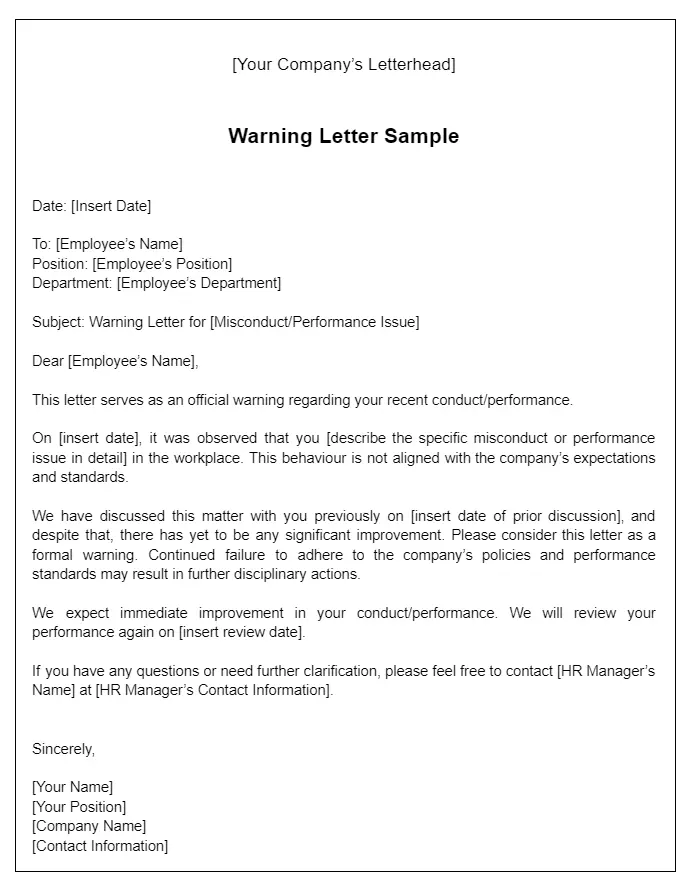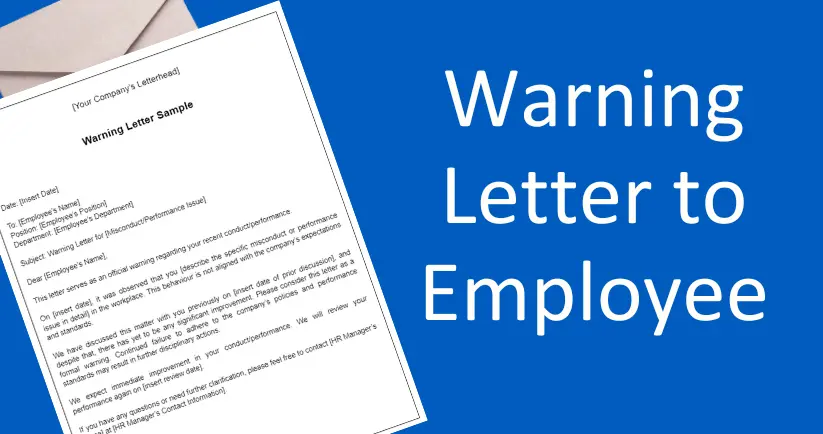Workplace Discipline, office policy-related work protocols, or a proper code of conduct is essential for all employees. It facilitates the company’s work and maintains proper overall workforce management. However, every company encounters employee-related hassles like staff misconduct, massive absences, consistent late marks, and poor performance throughout its business tenure. This continuous negligence may have severe consequences for company target achievement and business profit.
The company warns the employees verbally or sends a warning letter to employee to reinstate discipline. If the warning fails, the company takes disciplinary action against the employees.
Now, the query appears about strategically processing warnings so that an employer can remind employees about their work negligence without violating labour laws and related compliances. In some cases, company management might also warn the employees verbally before writing a formal letter. Since misconduct and policy violations are possible, it is essential to understand warning letters and how to write them.
What is a Warning Letter?
A warning letter is a written formal document issued by employers to their employees to address warnings against any misconduct, misbehaviour, poor performance, or violation of company policies in the workplace.
This process allows HR managers to control workplace mismanagement using numerous employee management tools, such as performance management system, and to take necessary actions that follow state—or central-based labour law and company policies.
Warning Letter Sample for Employee
Writing a warning letter may take a long time for employers. As they have to mention the reason behind delivering the letter briefly. Here, we are sharing a ready-made structure of the warning letter sample, so that you have to face challenges while drafting it.

Top 7 Warning Letter Format for Employee
Here, we are highlighting the top 7 formats of warning letter format. let’s explore it together.
1. Warning Letter to Employee for Poor Performance
[Your Company Letterhead]
Warning Letter
[Date]
[Employee’s Name]
[Employee’s Position]
[Employee’s Department]
[Company Name]
Subject: Formal Warning Letter to the employees with their Poor Performance
Dear [Employee’s Name],
We are writing this letter to warn you regarding your dissatisfactory performance at [Company Name]. Over the past [time period, e.g., three months], we have observed several areas where your performance has not met the company’s expectations that were outlined in your job description and our company standards. Some specific areas of concern are [Describe the performance issue, including specific examples and dates].
It is crucial for the success of our team and the company that all employees meet their performance targets and contribute positively to our goals. We have already discussed verbally and provided feedback to you on [dates of prior meetings or reviews], but there has been insufficient improvement to date.
For the last time, to address these concerns and support your improvement, we are implementing the following Performance Improvement Plan (PIP), which will be discussed in the next mail.
It is imperative that you demonstrate significant improvement in your performance by [specific date, e.g., the end of the PIP period]. If you fail to meet the outlined goals and expectations, you may be subject to further disciplinary action, up to and including termination of employment.
Please acknowledge receipt of this letter and your understanding of its contents by signing and returning the enclosed copy. If you have any questions or require clarification, please do not hesitate to contact [Supervisor’s Name] or [HR representative’s name] at [HR representative’s contact information].
Sincerely,
[Your Name]
[Your Position]
[Company Name]
[Contact Information]
2. Warning Letter to Employee for Absenteeism
[Your Company Letterhead]
Warning Letter
[Date]
[Employee’s Name]
[Employee’s Position]
[Employee’s Department]
[Company Name]
Subject: Formal Warning for Absenteeism
Dear [Employee’s Name],
This letter is to provide you with a formal warning regarding your recent absenteeism. Over the past [time period], we have noticed you have been skipping work randomly without proper notification or valid reasons.
Regular attendance is crucial for maintaining productivity and team morale. You are expected to improve your attendance immediately. Your continuous absenteeism may lead to further disciplinary action, including termination of employment.
Please acknowledge receipt of this warning by signing below.
Sincerely,
[Your Name]
[Your Position]
[Company Name]
[Contact Information]
3. Warning letter to the Employee for Misconduct or Violating Rules
[Your Company Letterhead]
Warning Letter
[Date]
[Employee’s Name]
[Employee’s Position]
[Employee’s Department]
[Company Name]
Subject: Formal Warning for Misconduct
Dear [Employee’s Name],
We are writing this letter to formally warn you regarding your recent misconduct at [Company Name]. Since (specific time), we have been observing your behaviour with team members or senior professionals violates our company policies, specifically [detail the misconduct or policy violated, e.g., inappropriate behaviour, breach of company rules, etc.].
Maintaining a professional and respectful workplace is one of the key mottos for organizational success and the well-being of our team. Such conduct is unacceptable and does not align with the company’s standards and values. The company is compelled to take serious steps to address this type of misconduct, which can be effective immediately.
Sincerely,
[Your Name]
[Your Position]
[Company Name]
[Contact Information]
4. Warning letter for Unprofessional Behaviour
[Your Company Letterhead]
Warning Letter
[Date]
[Employee’s Name]
[Employee’s Position]
[Employee’s Department]
[Company Name]
Subject: Formal Warning for Unprofessional Behavior
Dear [Employee’s Name],
We are writing this letter to warn you formally regarding your unprofessional behaviour observed over the past few weeks. Specific incidents include [briefly describe incidents, e.g., inappropriate comments, lack of cooperation with team members, disregard for company policies, etc.], occurring on [specific dates].
Such conduct is unacceptable and undermines the professional environment we strive to maintain at [Company Name]. Effective immediately, you are required to exhibit professional behaviour, adhere to company policies, and show respect to colleagues and clients.
If you fail to improve, further disciplinary actions, including termination of employment, may result. We expect immediate and sustained changes in your behaviour.
Please acknowledge receipt of this warning by signing below.
Sincerely,
[Your Name]
[Your Position]
[Company Name]
[Contact Information]
5. Warning Letter for Coming Late
[Your Company Letterhead]
Warning Letter
[Date]
[Employee’s Name]
[Employee’s Position]
[Employee’s Department]
[Company Name]
Subject: Formal Warning for Consistent Tardiness
Dear [Employee’s Name],
This letter serves as a formal warning regarding your repeated late arrivals to the office over the past [specific time period, e.g., month]. We have given repeated verbal warnings to you regarding coming late to the office every other day. But there is no such heed paid to those warnings.
We are writing this letter to warn you about your contemptuous behaviour. You are expected to adhere strictly to your designated work hours. Your continuous tardiness may compel us to take some strict disciplinary actions, including the termination of employment.
Please acknowledge receipt of this warning by signing below.
Sincerely,
[Your Name]
[Your Position]
[Company Name]
[Contact Information]
6. Warning Letter For Irregular Attendance
[Your Company Letterhead]
Warning Letter
[Date]
[Employee’s Name]
[Employee’s Position]
[Employee’s Department]
[Company Name]
Subject: Formal Warning for Irregular Attendance
Dear [Employee’s Name],
I am writing this letter to inform you that despite repeated verbal warnings of your irregularity in the workplace, you haven’t improved. The attendance record clearly shows that since ( date), you have been taking numerous days off without seeking any permission.
Moreover, your work performance has been unsatisfactory for the last two months. Your frequent and unexplained absences on [list specific dates] have raised concerns regarding your commitment and impact on team productivity.
If there is no immediate and sustained improvement in your attendance, we will have to consider further disciplinary actions, which could include termination of your employment.
Please acknowledge receipt of this warning by signing below.
Sincerely,
[Your Name]
[Your Position]
[Company Name]
[Contact Information]
7. Warning Letter to Employee for Misconduct
[Your Company Letterhead]
Warning Letter
[Date]
[Employee’s Name]
Subject: Warning Letter for Misconduct
Dear [Employee’s Name],
I am writing to formally address your recent misconduct at the workplace, which is a severe violation of our company policies and standards of conduct. Specifically, [describe the misconduct, e.g., insubordination, harassment, breach of safety protocols, etc.].
Such unacceptable behaviour undermines our company’s values and the professional environment we strive to maintain. Immediate corrective action is necessary to prevent further repercussions.
Effective immediately, you must [state corrective actions or behaviour expected, e.g., adhere strictly to company policies, attend sensitivity training, etc.]. Failure to comply may result in further disciplinary measures, including possible termination of employment.
Please take this warning seriously and demonstrate a commitment to upholding our company’s standards of conduct. To discuss this matter further, a follow-up meeting is scheduled for [Date and time].
Please consider this as a final warning regarding your conduct.
Sincerely,
[Your Name]
[Your Position]
[Company Name]
Purpose of Writing a Warning Letter
Here are some everyday purposes based on which an employer may issue a warning letter to an employee:
- Irregularity
- Theft
- Violation of Safety Management
- Violation of Company Policies
- Workplace Harassment
- Poor performance
➔ Irregularity
When management notices that employees are frequently absent from the workplace or have consistently maintained irregularity, they may plan to discipline them by delivering a warning letter addressing the need to maintain regularity on office premises.
➔ Theft
Theft is an offence, as is who, where, and when it is performed. Often, employees steal their colleagues’ data to build up their own authority. This creates misperceptions within the workplace that lead to employee disengagement. The organization may warn them in written form about their fraudulent activities.
➔ Violation of Safety Management
Employees seek safety and security from any organization they belong to. So, organizations create safety policies for employees, which are informed to employees during onboarding. If any employee violates the policy, management can tell them through a warning letter.
➔ Workplace Harassment
Suppose the organization notices any employee who tends to harass female colleagues by showing irrelevant pictures or videos or using vulgar language/signs. In that case, the management will follow a specific process to issue a warning letter against them. This process includes a thorough investigation, a chance for the accused to present their side, and a decision made by our company’s policies. In this case, if any employee complains to HR about their irritation, the organisation also takes it seriously.
➔ Violation of Company Policies
Every company has its policies and code of conduct, which organizations highlight during onboarding. Besides, there are numerous state—and central-based labour laws related to acts and compliances that employees are bound to follow. Management notices whether employees maintain company policies and related government acts and compliances. They warn the employees by delivering a warning letter if they violate the rules.
➔ Poor performance
It is pretty common in the corporate world for employees to fail to meet the organization’s goals. However, suppose management notices that a particular employee’s lousy performance has been continuing for a specific duration, and the employees have taken this for granted. In that case, the organization can issue a warning letter to the employees based on their poor performance.
How to Write a Warning Letter
Writing a warning letter differs from drafting a random daily email. In regular email writing, mistakes or wrong wordings may not have serious consequences. However, in the case of a warning letter, even a small mistake can lead to significant and potentially bitter impacts. Therefore, it is crucial to approach the drafting process differently. We are sharing a detailed step-by-step guide below; let’s explore this new approach together.
1. Email Header
First, ink down your company’s letterhead, which usually contains the company name, address, shareable information, logo, etc. Along with the letterhead, mention the date you are going to deliver the warning letter to the candidate.
2. Recipient Details
Next, you must add the recipient’s name along with his job title. If you have more than one employee with the same name, you can also add the department details.
3. Addressing
Start the letter body by writing the recipient’s name and addressing them with an emotional touch, like ‘Dear'[Employee’s Name]. Start with a solid subject line so that the employee understands the purpose of the letter correctly.
4. Highlighted Issues in-details
In the letter body, it is essential to clearly specify the reason for delivering the mail to the recipient. It is beneficial to use inflammatory language and update the proper date, time, relevant details, and examples to support your claims. In case the purpose of writing the letter is the employee’s poor performance, you can offer some training programs using the training management system and associate tools.
5. Company Policies and Expectations
Along with the proper reasons, you should add company policies and related acts and compliances. By highlighting this, you can remind employees about the behaviour and performance level you expect from them.
6. Impact or Consequences
In the summary of the letter body, explain the potential consequences the employees may face once they continue the misconduct or performance issues.
7. Closing
The closing should be a bit sympathetic. By providing a scope for discussing any concerns or questions they may have, you can reiterate the seriousness of the situation.
8. Signature
Sign your signature along with details of your position. If you send an e-mail, you can add a digital signature along with your typed name and position.
Things to consider while writing a Warning Letter
Before writing the employee warning letter, you must consider certain things included in the warning letter format before delivering it to that employee. These are:
➔ Review Employee Behavior
Before starting writing, review employees’ behaviours thoroughly. There can be numerous reasons behind an employee’s disengagement and distraction from their responsibility.
➔ Language and Tone
Maintaining a formal writing tone and professional language is one of the key features to consider when writing a warning letter. While writing, remember to keep your tone professional, not seem threatening or discourage employees’ morale, as the principal motto of writing is to improve employee behaviour.
➔ Content Structure
The letter structure should be adequate; misplaced information and incorrect input can lead to serious consequences. The warning letter should be written as follows:
- Mention the date of the warning.
- Put the name of the person and the company name.
- Add a proper subject.
- Write the reason for writing a warning letter in detail.
- Mention the reason the company will take for negligence of the letter.
- Include signature.
➔ Proofread
Proofreading the written material before email delivery is essential to prevent conflict due to minor errors or word misplacement. In this scenario, if management uses some wrong wording in warning letters, the employees can file management harassment complaints against the email sender. One more noticeable thing before delivering the warning letter is that it is sent to the right person with the correct details.
➔ Acknowledgement
Once the letter is delivered, it is essential to review whether the employee received the mail; in such a scenario, management can provide physical mail along with sending the email.
Future Outlook
Receiving a warning letter seems terrific for employees. So, when writing the warning letter, it is essential to include a soft statement that offers support and assistance to the employees so that they can reach out to you if they need clarification about the warning. Think twice before delivering the warning to an employee, as it can be petrified for them. Ultimately, the end goal of your warning letter should also be employee behaviour improvement and performance enhancement to bring betterment to your product’s future.
FAQs on Warning Letter
1. Does a final warning mean termination?
A final warning is the last warning before initiating the termination process. If one neglects the final warning, he can be terminated at any time.
2. Can you give 2 final written warnings?
No. First, you can warn verbally by sending one verbal warning email. Then, you can send two written warnings (one initial and one final) before terminating them.
3. How long is a final warning valid?
The final warning is generally valid for around 12 months. However, it depends on the company’s policy; often, the company sets it around 3 to 6 months as well.
4. Can a written warning be withdrawn?
Yes, the recipient of the warning letter is guilt-free, or you delivered the letter to the wrong person; it can be withdrawn by providing a withdrawal letter to that employee mentioning your reasons for withdrawal.
5. How many Warning Letters does an employee get before termination?
Generally, an employee receives a minimum number of 2 warning letters before termination.









